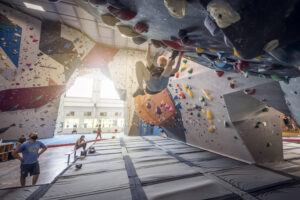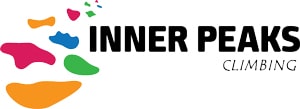
Indoor rock climbing is a dynamic and engaging sport that offers something for everyone, whether you’re aiming to tackle challenging routes or simply looking to improve your skills recreationally. A key concept in climbing is projecting—a focused effort on attempting and eventually completing a specific route or boulder problem. This blog will guide you through the process of goal setting in indoor rock climbing, with a special focus on the art of projecting, making it relatable for both serious climbers and those who climb for fun but want to see progress.
What is Projecting in Rock Climbing?
Projecting is the process of working on a challenging route over multiple sessions until you successfully complete it. This involves repeatedly attempting the route, analyzing each move, and developing strategies to overcome difficulties. Projecting can take varying amounts of time depending on the route’s difficulty and the climber’s skill level—it can range from weeks and months to even years, both indoors and outdoors.
Examples of Projecting
- Indoor Projecting: You might select a difficult boulder problem or route at your local gym that challenges you. Each session, you work on different sections, refine your technique, and gradually link the moves together until you complete the climb.
- Outdoor Projecting: Outdoors, projecting can be more prolonged due to factors like weather and access. Climbers often return to the same outdoor route multiple times over several months or even years, continually working on specific moves and building the strength and skill needed to complete the climb.
Measuring Progress in Projecting
To track your progress while projecting, consider the following:
- Redpoint Attempts: Count the number of attempts it takes to complete the route without falls or rests.
- Milestones: Break down the route into sections and track your ability to complete each section consistently.
- Time Investment: Keep a log of the hours or sessions spent working on the project.
- Technique Improvement: Note improvements in specific techniques or moves that are critical to the route.
Why Set Goals in Indoor Rock Climbing?
Goals provide direction and motivation, helping climbers stay committed to their practice. They allow you to track your progress and celebrate achievements, which can be incredibly rewarding. Whether you’re aiming to advance to more difficult routes or simply want to climb more fluidly, having clear goals can make your climbing experience more structured and fulfilling.
Steps to Effective Goal Setting
- Assess Your Current LevelStart by understanding where you currently stand. Reflect on your strengths and weaknesses, and consider seeking feedback from fellow climbers or coaches. Knowing your baseline helps in setting realistic and achievable goals.
- Define Your GoalsSet both short-term and long-term goals to keep yourself motivated over time.
- Short-Term Goals: These should be achievable within a few weeks to a couple of months. For example, “Complete a V3 boulder problem” or “Improve my footwork.”
- Long-Term Goals: These goals should challenge you and require consistent effort over several months or even years. Examples include, “Climb a 5.12 route” or “Increase my overall climbing endurance.”
- Make Your Goals SMARTEnsure your goals are Specific, Measurable, Achievable, Relevant, and Time-bound.
- Specific: Clearly define what you want to achieve. Instead of “Get better at climbing,” try “Complete a 5.10d route without falls.”
- Measurable: Track your progress. For instance, count the number of routes you climb each session.
- Achievable: Set goals that are challenging but within reach based on your current abilities.
- Relevant: Your goals should align with your personal interests and motivations in climbing.
- Time-bound: Set deadlines to keep yourself accountable. For example, “Send a 5.11b route by the end of summer.”
Goal Setting for Serious Climbers
If you’re aiming to take your climbing practice seriously, your goals might be more specific and technically demanding. Here are some examples:
- Improve Technique: Focus on mastering specific techniques like heel hooks, dynos, or crimps. Set a goal to incorporate these techniques into your climbing sessions regularly.
- Increase Strength and Conditioning: Develop a training regimen that includes hangboard exercises, campus board workouts, and general strength training. Aim to see measurable improvements in your grip strength and overall fitness.
- Route Projecting: Select a challenging route and work on it systematically. Break it down into sections, practice each part, and set a goal to link the entire route within a set timeframe.
Goal Setting for Recreational Climbers
For those who climb more recreationally but still want to see progress, goals can be more flexible and enjoyment-focused:
- Climb Consistently: Aim to climb a certain number of times per week or month. Consistency is key to gradual improvement.
- Try New Routes: Push yourself to climb different styles and grades. Set a goal to try a certain number of new routes each month.
- Have Fun: Incorporate fun goals, like participating in climbing games or social climbing events. For example, “Join a bouldering competition for fun” or “Climb with three new partners this month.”
Softer Aspects of Goal Setting
Beyond the technical aspects, goal setting in climbing also involves softer, more personal elements:
- Mindset and Confidence: Work on developing a positive mindset. Set goals to overcome mental barriers, such as fear of falling or self-doubt.
- Community and Support: Engage with the climbing community. Set goals to participate in group climbs, find a mentor, or attend climbing workshops.
- Enjoy the Journey: Remember that progress takes time. Set goals that allow you to appreciate the journey, celebrate small victories, and enjoy every climb.
Final Thoughts
Projecting and setting goals in indoor rock climbing are powerful ways to enhance your experience, whether you’re a serious climber aiming for specific advancements or a recreational climber looking to progress. By assessing your current level, defining SMART goals, and considering both technical and personal aspects, you can create a fulfilling and enjoyable climbing practice. So, take some time to reflect, set your goals, and start climbing towards your aspirations.


